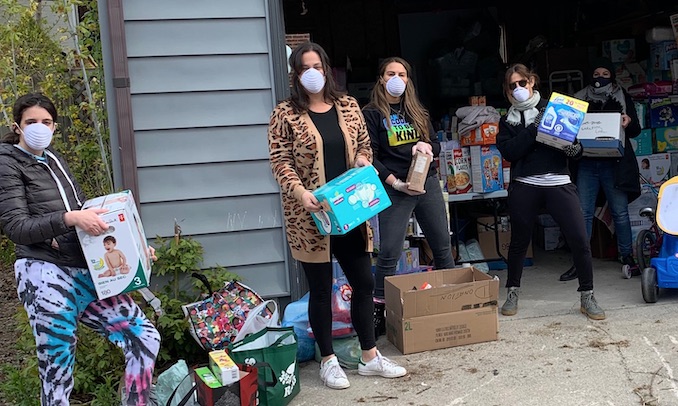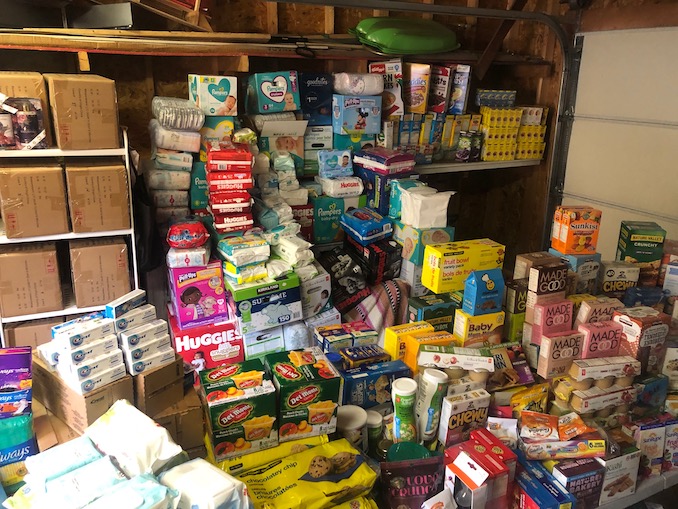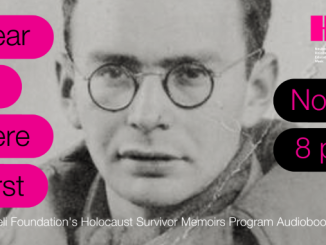In these past few months, so much of our lives have changed. We’ve had to try to keep it together, while being apart. The impact of the pandemic has affected us all but more so for those living in the city in the most challenging environments. For our segment of society who are homeless and those who seek shelter for safety, the needs are much greater than wondering if shorts are acceptable attire for a zoom conference call. A group of women in Toronto recognized the need and acted upon it to create #one2give — a charity that collects essentials for not-for-profit organizations and shelters.

Like so many others, when physical distancing came into play several months ago, the women each felt the urgency to do something for those in Toronto, particularly women, who they realized would be dramatically impacted by these changes. According to their research provided, domestic violence related calls to support services have increased at an alarming rate of 300% to 400%. “We wanted to find a sustainable way to garner long term support for shelters across the GTA,” said Jessica Green. “Most have been hit hard due to a pandemic-related surge in poverty, homelessness, and domestic violence (bed and meal needs, for instance, have multiplied). Ironically, public health warns that one’s home is the safest place to be right now, but not everyone has the luxury of a home with access to hygiene and the opportunity to physical distance. Not to mention, for people who are trapped at home with an abuser, home is actually not the safest place to be right now. As a result, social support organizations are operating at capacity, over-budget, and in need of essential items like never before.”
In response, Jessica Green, Lindsay Detsky, Fern Brody, Leah Potash and Erica Berlin created #one2give. Their mandate is very simple: to change the donation mindset from large-but-finite to small-and-sustainable.
They also recognized that many charities are asking for donations more so than ever. But the idea of #one2give was to not overstretch people at this time. Instead, they encourage any amount of in-kind support that would hopefully pave a path to future giving.
“Our goal was not necessarily to raise a lot of money, but rather to change people’s habits and mindsets. We envision a community where people incorporate giving into their daily routine. We hope that by engaging as many people as possible, we will garner long-term support for many shelters, long after COVID-19 has resolved and many of our lives return to normal,” said Green.
So, what makes this charity different? Green tells us each month, #one2give selects a partner organization and answers its simple – but critical – list of needs. These needs (such as soap, toothpaste or cleaning supplies) are often on most shopping lists, so #one2give asks donors to add two of any item to their cart: one to keep and #one2give.
“Everyone should have access to these basic items — no one should ever have to choose between sanitary hygiene and food. And yet, here we are, with thousands of people having to make these decisions. In our small, grassroots way, we’re trying to say you are worthy of these things,” said Green.
We like this idea of sharing the giving amongst a variety of shelters and organizations in the city. It offers up an opportunity to learn more about our communities and how their services are provided to those in need.

“Based on the success of the movement’s first month in support of Nellie’s Shelter for women and children leaving situations of violence and poverty, #one2give will be an ongoing initiative,” said Green. “This month, we are working with Sistering, a multi-service agency for at-risk, socially isolated women and trans people in Toronto who are homeless or precariously housed.”
With the pandemic still active and the sensitivity of having in-kind items donated in the most hygienic way what should we know when we’re getting ready to give? Green tells us that they consult with the partner organizations. “It’s so important to us to work in partnership with these shelters, and we structure our campaign based around their current safety protocols.” For example, in their current partnership with Sistering, they can only accept brand new products that have been requested by the shelter and can be disinfected upon delivery.
In addition, they’ve set up 13 contactless Drop Spots around the city, where people can safely donate items and do so with safe physical distancing. For those who want to donate, but are unable to leave their homes, they’ve also arranged for volunteer drivers for contactless pick-ups. Another way to give is through gift cards as they can be easily disinfected and give Sistering’s participants the opportunity to purchase based on individual needs.
So, how does #one2give decide which organizations to donate to? “There are so many organizations that do vital work across the GTA that it’s not easy to make a decision,” said Green. “The #one2give team has focused on agencies that service women and other particularly vulnerable communities, such as children and trans people. In addition to selecting partners that have experienced an increase in need due to staying open throughout the pandemic, one criteria is that partner agencies have the space to accommodate a large influx of supplies.”
The #one2give initiative is currently servicing Toronto organizations but are hoping to expand outside of the city with like-minded volunteers.
To keep informed about the organizations they are partnering with and where to donate, follow the #one2give on Instagram – they have a few posts there. You can also reach out if you’re interested in joining the movement to a Drop Spot. They can be reached at one2givetoronto@gmail.com.
The next contactless donation drop off :
Where: Sistering (957 Bloor St. W.)
When: June 8 from 12pm to 2pm




